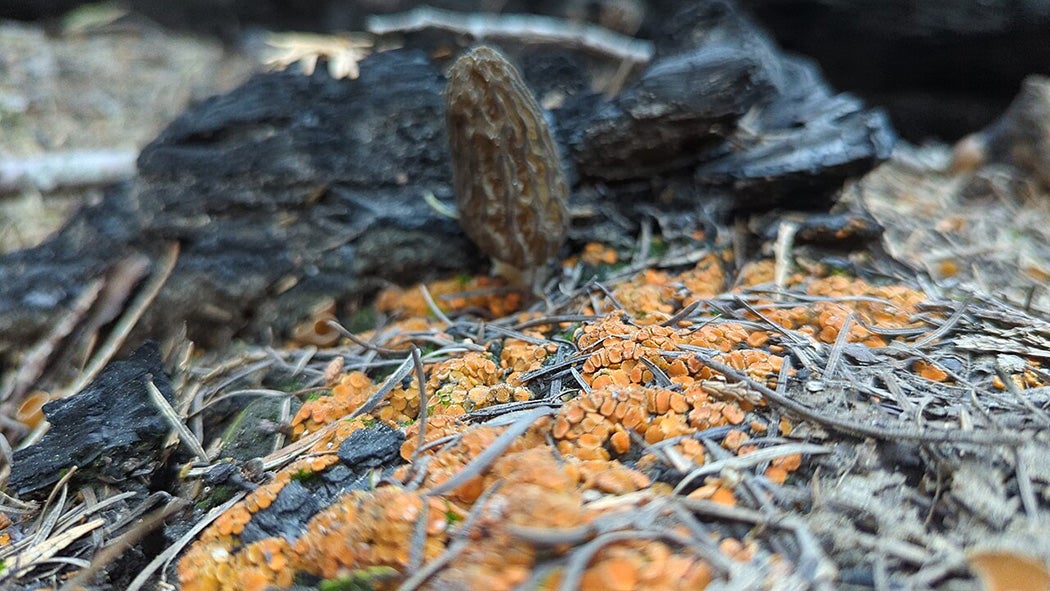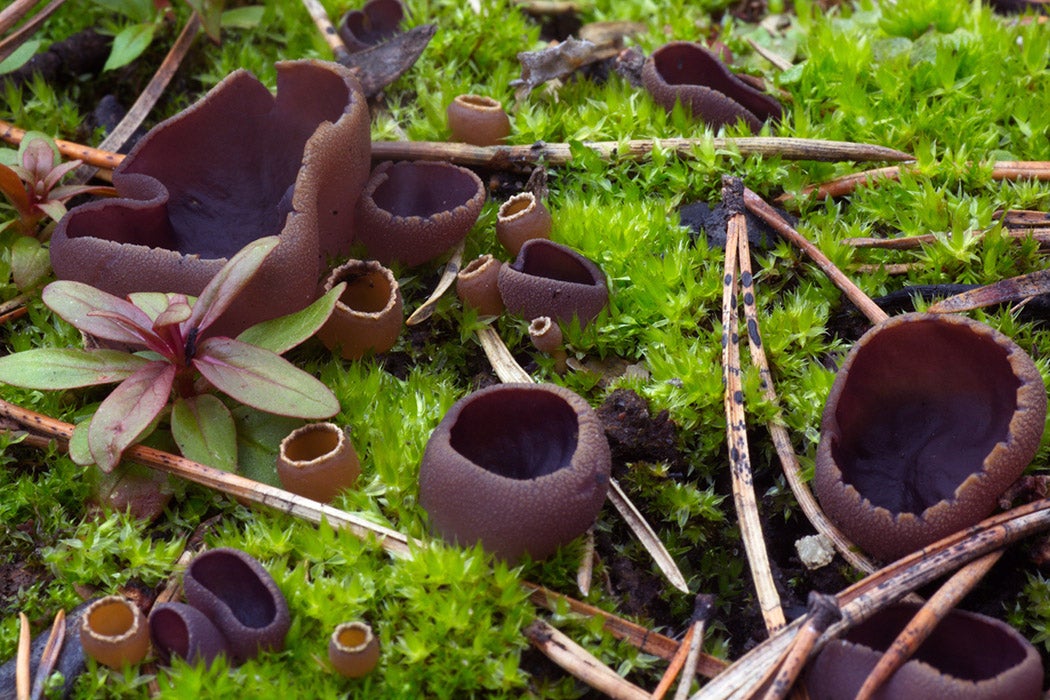In 1834, German naturalist Carl Gustav Carus and his daughter Mariane were walking in a forest when she spotted a pile of burned wood and charred earth that looked aglow. Closer inspection revealed it to be masses of bright orange “peculiar mold vegetation,” as Carus later described it; he named it Pyronema marianum, reflecting its association with fire and honoring his child. He published microscopic studies of Pyronema marianum that year, writing “the effect was as if a mass of coal, no longer smoking, was glowing, poorly concealed, out of the black earth” (translations are mine). And so, appropriately, a fungus resembling embers kicked off the science of “pyrophilous,” or fire-loving, fungi.
Now called Pyronema omphalodes, this fascinating fungus and its cousin Pyronema domesticum rapidly cover charred ground with masses of tiny, brightly hued fruiting bodies that are to fungi what pears are to trees—sex organs. Technically not mushrooms, which have a cap and stalk, the fruiting bodies are blob- to cup-shaped, while the fungus itself lives hidden underground.
“I’ve actually gotten emails from wildland firefighters and forest service folk, [asking], like, ‘What is this stuff?’” says mycologist Monika Fischer, whose love of fungi and fascination with fire—she’s a fire dancer—converged in her studies. Multiple fires burned near her home in California during the devastating 2020 wildfire season, and she describes a rainbow of fungi emerging as soon as any rain or fog reached the burn scars.
“I got really interested in how all of these fungi thrive immediately after a fire,” she says.

Indeed, Pyronema isn’t alone: there’s the violet fairy cup (Peziza violacea), the charcoal-loving fairy cup (Geopyxis carbonaria), the charcoal eyelash fungus (Anthracobia melaloma) and a slew of other fancifully named fungi. Some pyrophilous fungi produce large, tasty, edible fruiting bodies after a fire—to wit, burn morels (various Morchella species) that lure foragers with dreams of exquisite feasts.
“We find them all the time. It’s a nice little bonus to also collecting samples,” notes Amelia Nelson, who recently completed her doctoral work on the impact of wildfire on soil microbes.
Morels may be one reason why people noticed the link between fire and fungi in the first place. For example, here’s a tip on “cultivating” mushrooms from the Geoponica, a collection of agricultural writings compiled in tenth-century Constantinople:
“[I]f you wish to raise mushrooms from the soil…heap up dead shoots, and all things of a combustible nature…and if a shower is impending, set fire to them; for thus mushrooms will be spontaneously produced.”
People have capitalized on this knowledge all over the world. Indigenous communities such as the Mono, Yurok, and Me-Wok along the West Coast of North America have a history of using fire to trigger fruiting of morels and other desired fungi. Their use of burning to manage forest habitats dates back thousands of years. Now such cultural burning practices are making a comeback after suppression by the US government throughout most of the twentieth century. Indeed, for most of that period, federal forest managers didn’t recognize the value of such stewardship practices.
Scientists first cultivated pyrophilous fungi in the lab more than a century ago to study their biology, coaxing Pyronema to grow in petri dishes, using heat to reproduce its fire-stimulated fruiting and experimenting with its spores (fungal “seeds”). By the mid-1930s, researchers had recognized multiple species of pyrophilous fungi that appear in burn scars and were trying to learn what fire does to soil to promote their production.
“I’m always blown away to look at the papers from many decades ago where people did a lot of valuable science,” says mycologist Laura Bogar, who studies the symbiotic relationships between plants and soil fungi that shape ecosystem evolution. “Now we have molecular tools.”
These tools let mycologists “see” what those working a century ago, aided only with microscopes, could not. Today’s molecular tools are handy when studying life forms that seemingly disappear in between fires.
While research on pyrophilous fungi proceeded at a slow pace through the twentieth century and into the twenty-first, it’s gained momentum over the past several years thanks to technological advances and more extreme wildfires.
“Growing up…in Indiana, I never once smelled wildfire smoke,” comments Nelson. But after living in Colorado during the unprecedented 2020 wildfire season, she says that the importance of her research hit home. Periodic fires are important to the health of fire-adapted ecosystems such as conifer forests, oak woodlands, and shrublands, but climate change and fuel accumulation from over a century of fire suppression in the West and elsewhere are causing larger, more frequent, and more severe fires, according to a recent study in Nature Communications. This has kindled interest in pyrophilous fungi as burn scar pioneers that may be foundational to ecosystem recovery.
Accordingly, pyrophilous fungi appear after wildfires in disparate ecosystems. In fact, Fischer saw many of the same fungal species during her 2020 tour of burned black oak-bay laurel, redwood, and mixed conifer forests, as well as coast live oak woodland. She also saw them after prescribed burns in a mixed conifer forest. Mycologist, professor, and avid forager Sydney Glassman sees the same trend.
“What we’ve found is that we have really similar groups of fungi, and bacteria too, that are coming up regardless of the system we’re in,” Glassman notes.
This includes, amazingly enough, “galvanized steel buckets from Home Depot” filled with forest soil, topped with flammable material, and set alight. Moreover, different types of fire-loving fungi seem to arrive in waves over the ensuing weeks, months, and even years after a fire. And while some ecosystems have a different community of pyrophilous fungi, the emergence of fire-loving fungi in multiple different habitats suggests a common role.
Part of figuring out what they’re up to involves tracking down where these “now you see them, now you don’t” fungi go in between fires. There’s evidence that some blow in from surrounding unburned areas or in smoke from the fire itself. Others may be hiding on-site in the soil as dormant, heat-resistant forms that mobilize in response to fire. For instance, the false truffle Rhizopogon olivaceotinctus, a resident of pine forests, has heat-tolerant spores, while Pyronema may live as heat-tolerant structures called sclerotia, which are “sort of the fungal equivalent of a potato,” says Fischer. Then there are “bodysnatchers” such as the bonfire scalycap (Pholiota highlandensis) that might live much of its life inside of a plant. But when its plant home burns in a fire, the fungus colonizes the soil and then fruits to spread its spores, which, in turn, inoculate new plants and start the cycle again.
As to what they’re doing after a fire, Glassman, Fischer, and others contend that they’re initiating ecosystem re-habitation.
“Those are the things that are the first responders after fire and are laying the foundation for recovery—it’s a really beautiful, incredible thing to witness,” says Fischer.

She points out that an intense fire significantly transforms soil chemistry. As a team led by Andrei S. Steindorff notes, fire leaves behind pyrogenic carbon (think “charcoal”), waxes, ash, and other substances that repel water and lead to erosion, while also altering soil nutrient availability—in short, an inhospitable environment for most organisms. But not for a pyrophilous fungus.
“They’re the things that initiate succession because they’re the things that survive,” notes Glassman. And the idea, she says, is that they make the soil more hospitable to other life forms.
For example, some pyrophilous fungi can grow as thick mats of mycelia that might hold soil together after a fire, slowing down erosion and nutrient run-off until plants and their root networks repopulate and take over. And experiments in jars of soil directly demonstrate that some can aggregate soil. Moreover, Steindorff et al. found evidence that pyrophilous fungi can eat the fire-generated substances that repel water and cause soil erosion.
Their weird consumption habits might also release nutrients trapped in these substances back into the soil for use by other returning life. Fischer and colleagues found, for instance, that Pyronema can eat charcoal, breaking it down and releasing its contents. Another way that Pyronema and other rapidly appearing pyrophilous fungi might improve soil nutrient availability soon after a fire is by growing profusely and then dying off, according to Fischer and collaborators. The appetizingly named “necromass” that they leave behind might feed subsequent waves of life.
Fire-loving fungi may also facilitate the re-greening of burn scars by forming symbiotic associations called mycorrhizae with newly emerging plant seedlings, allowing plants to reestablish themselves. Mycorrhizae, Bogar’s area of expertise, are important for the life and health of most plants, but wildfires kill most of the fungi that form them. Enter the aforementioned Rhizopogon olivaceotinctus, a mycorrhizal fungus with heat-resistant spores. Glassman and collaborators found that it significantly jumps in prevalence after a fire and quickly forms mycorrhizae with pine seedlings in burn scars and in greenhouse experiments.
“I think those are really important to be there to partner with plants, to get them going,” she says of the few known heat-resistant fungi that tie in with plant roots after a fire.
While scientists now have ideas about what some pyrophilous fungi might be doing, there’s still more unknown than known. Really understanding their roles in post-fire environments requires the ability to grow, store, and manipulate the fungi in the lab, in greenhouse experiments, and in those steel buckets—technically called “pyrocosms”—that allow researchers to more easily study what happens to both soil and fungus under different fire temperatures and durations. But, Pyronema aside, pyrophilous fungi are challenging to bring into the lab. Just ask Glassman, who’s initiated a project to create a culture collection, essentially a library, of pyrophilous fungi plucked from burned sites.
“A lot of these pyrophilous fungi are extremely finicky,” she says, with different species sometimes having wildly different preferences for how they’re grown and stored for future studies. And some that seem to be cooperating in a culture dish may suddenly expire. Nevertheless, the enormous effort behind the culture collection is paying off by allowing detailed mechanistic studies of what different species of pyrophilous fungi can actually do.
Weekly Newsletter
Understanding post-fire ecosystem recovery at a time when fires are increasingly severe will inevitably help inform post-fire management decisions. Given that, some researchers propose that if pyrophilous fungi improve soil conditions, it’s important to delay post-fire remediation efforts so the fungi have time to do their work. Additionally, Fischer proposes prescribed burning as an inoculation.
“It activates all of our pyrophilous guys and then they start producing spores, they start producing sclerotia,” she says. “So when a really destructive fire comes through, that spore bank is already there and ready to respond.”
Fischer also notes that chemicals in wildfire-generated charcoal are seen as carcinogens and pollutants in other contexts. That fire-loving fungi thrive in that chemistry means that we have a lot to learn from these organisms. And that data could be critical for polluted ecosystems everywhere.
Support JSTOR Daily! Join our membership program on Patreon today.







